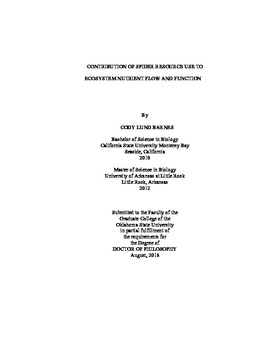| dc.contributor.advisor | Wilder, Shawn | |
| dc.contributor.author | Barnes, Cody Lund | |
| dc.date.accessioned | 2019-03-20T19:25:40Z | |
| dc.date.available | 2019-03-20T19:25:40Z | |
| dc.date.issued | 2018-08 | |
| dc.identifier.uri | https://hdl.handle.net/11244/317651 | |
| dc.description.abstract | At the interface of the interactions between organisms and their environments, nutrient cycling dynamics significantly shape ecosystems. Ecological stoichiometry focuses on the availability and balance of elements through ecosystems, however, elemental analyses can oversimplify the animal nutrition and physiology components of biochemical flow through ecosystems. The study of consumer-driven nutrient recycling traces the fate of ingested elements and other nutrients through consumer excretive processes and the role of nutrient deposition in ecosystem nutrient flow. But, the study of nutrient recycling has been largely limited to the interactions between primary producers and herbivores, generally in aquatic or pelagic systems. Research of predators could therefore broaden applications of nutrient recycling theory. The goal for my dissertation was to explore the mechanisms through which spiders influence ecosystem function. The scope of my research spanned the investigation of digestive physiology and excretion up to the broader assessment of how predators contribute to soil microbial communities and plant growth. I also sought to resolve applications of different nutrient frameworks, from elements to macronutrients. I first tested how variation in prey nutrient content affected the flow of nutrients through different pathways of spider physiology. Next, I tested whether prey exoskeleton influenced the flow of nutrient through web-building spiders as carcass deposition, assimilation, digestive metabolism, and excretion. While my first two dissertation chapters examined the forms of nutrient inputs by spiders, my third chapter examined how each of the nutrient inputs affects the flow of nutrients to soil communities and plant growth. Finally, I tested for spatial effects of predator nutrient supplementation to soil and plant systems. My results discern the nutrient cycling roles of spiders as opportunistic, generalist predators and predominantly indirect contributors to soil and plant processes. That is, while I found strong evidence that spiders assimilate more nutrients from less-chitinous prey and grow more on lipid-biased diets, I also found that spiders assimilated most available nutrients and there was not a difference in nutrients entering the soil interface based on prey composition. But, the labile nutrients comprising spider excreta were important for increasing soil decomposition of more complex nutrients and this indirectly bolstered plant growth and nutrients. Future study will be necessary for further elucidating the role of terrestrial predators in consumer-driven nutrient cycling. Finally, the inclusion of predators in future testing of consumer-driven nutrient cycling perspectives offers a broad opportunity to further advance the understanding of ecosystem nutrient flow and function. | |
| dc.format | application/pdf | |
| dc.language | en_US | |
| dc.rights | Copyright is held by the author who has granted the Oklahoma State University Library the non-exclusive right to share this material in its institutional repository. Contact Digital Library Services at lib-dls@okstate.edu or 405-744-9161 for the permission policy on the use, reproduction or distribution of this material. | |
| dc.title | Contribution of spider resource use to ecosystem nutrient flow and function | |
| dc.contributor.committeeMember | Fairbanks, Sue | |
| dc.contributor.committeeMember | Jeyasingh, Punidan | |
| dc.contributor.committeeMember | Loss, Scott | |
| osu.filename | Barnes_okstate_0664D_15840.pdf | |
| osu.accesstype | Open Access | |
| dc.type.genre | Dissertation | |
| dc.type.material | Text | |
| thesis.degree.discipline | Integrative Biology | |
| thesis.degree.grantor | Oklahoma State University | |
